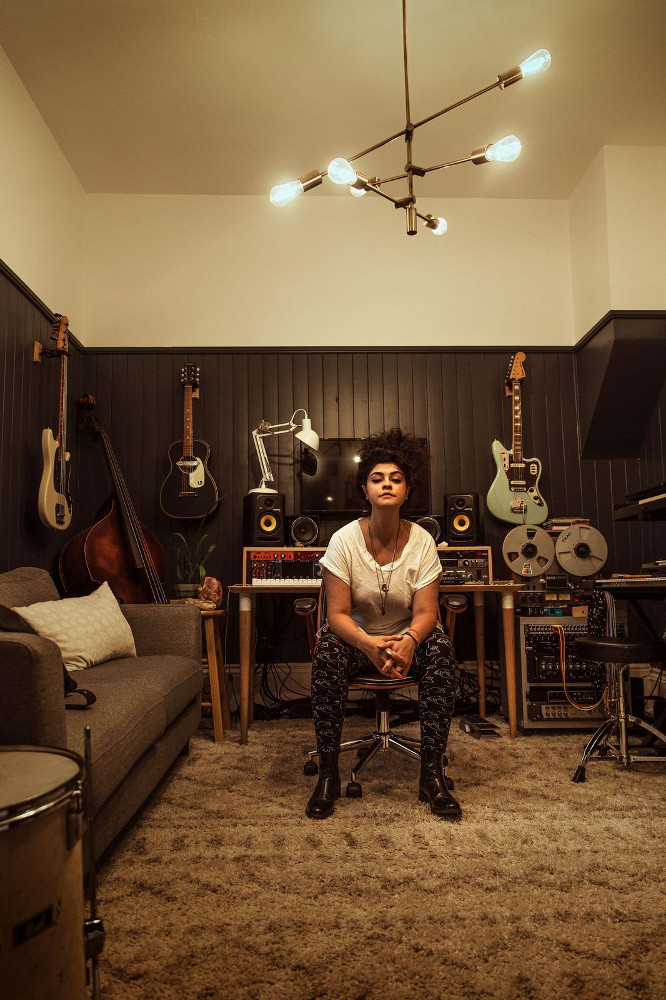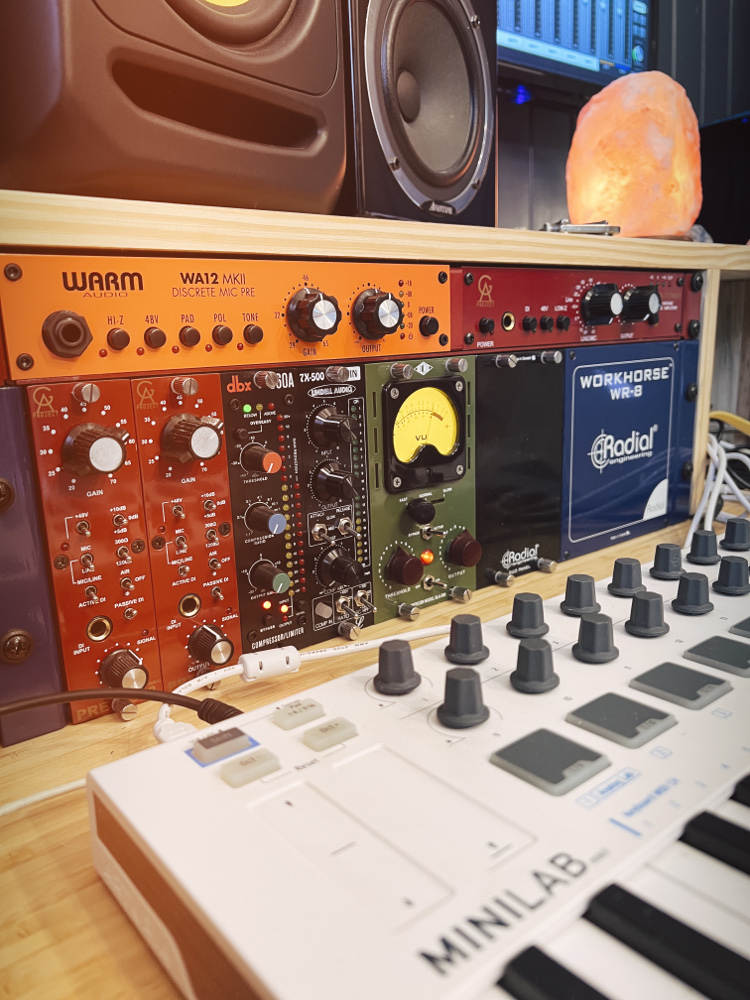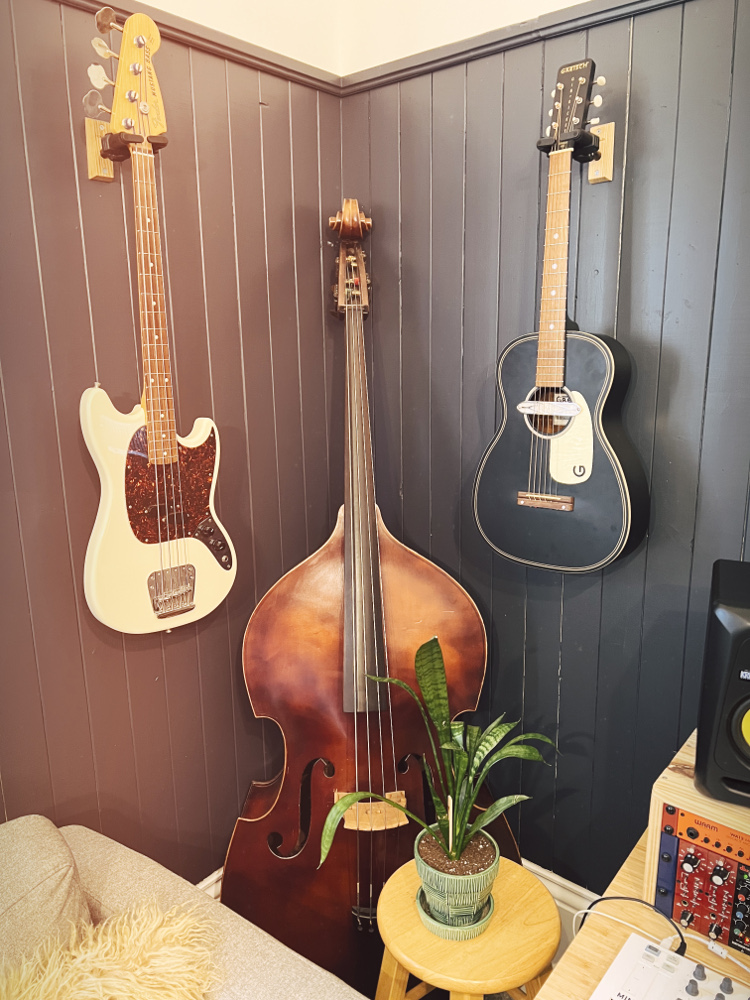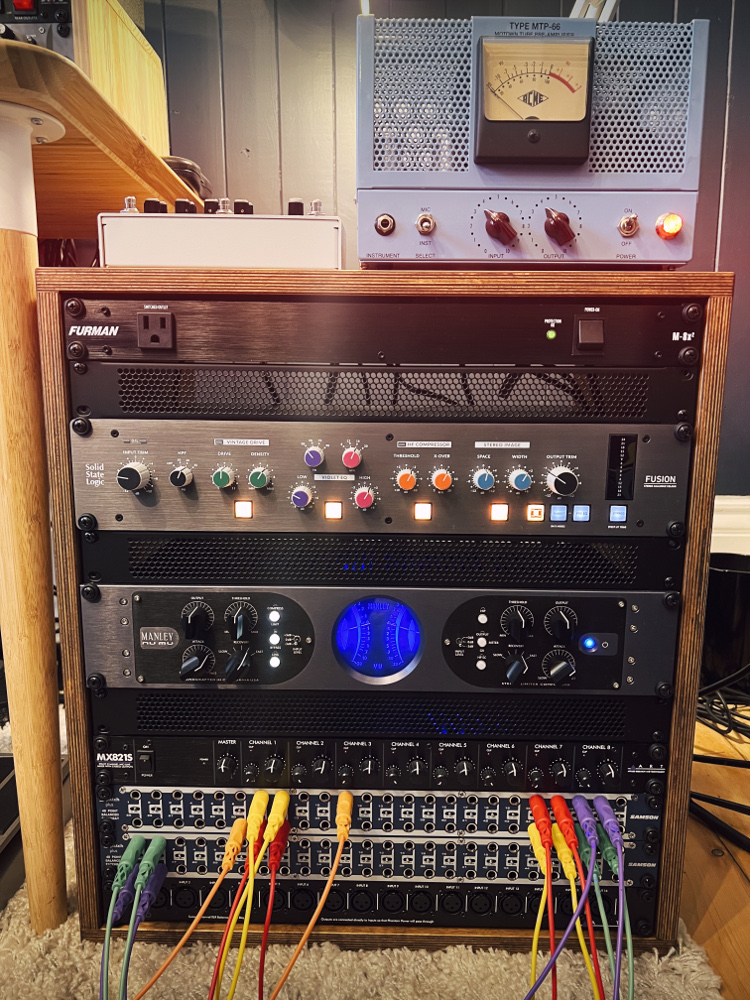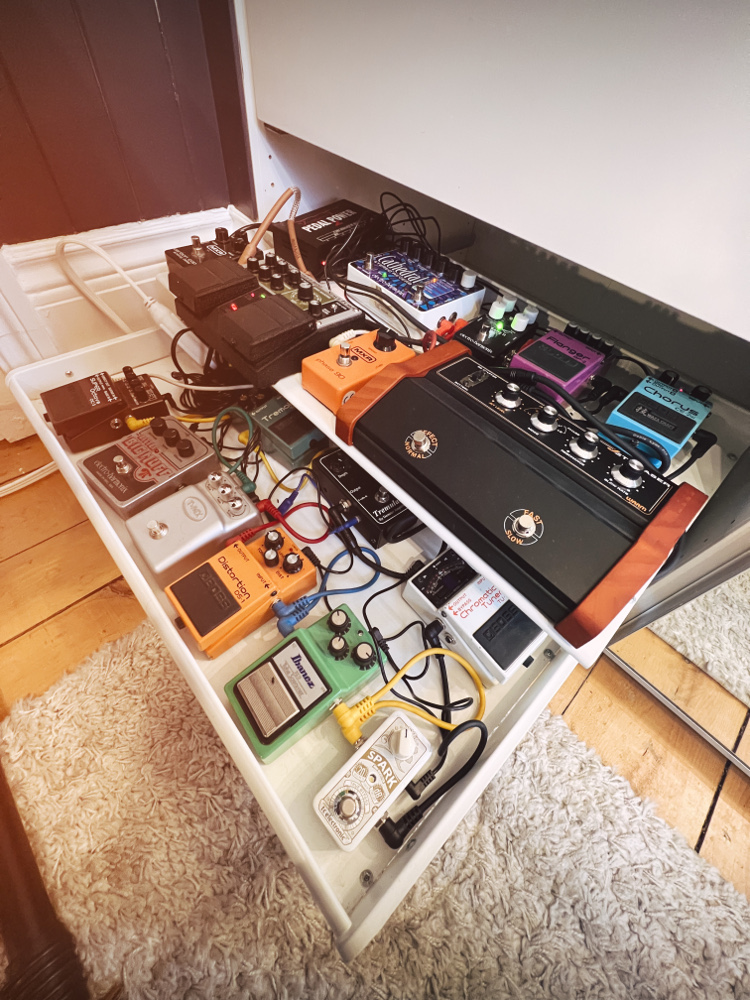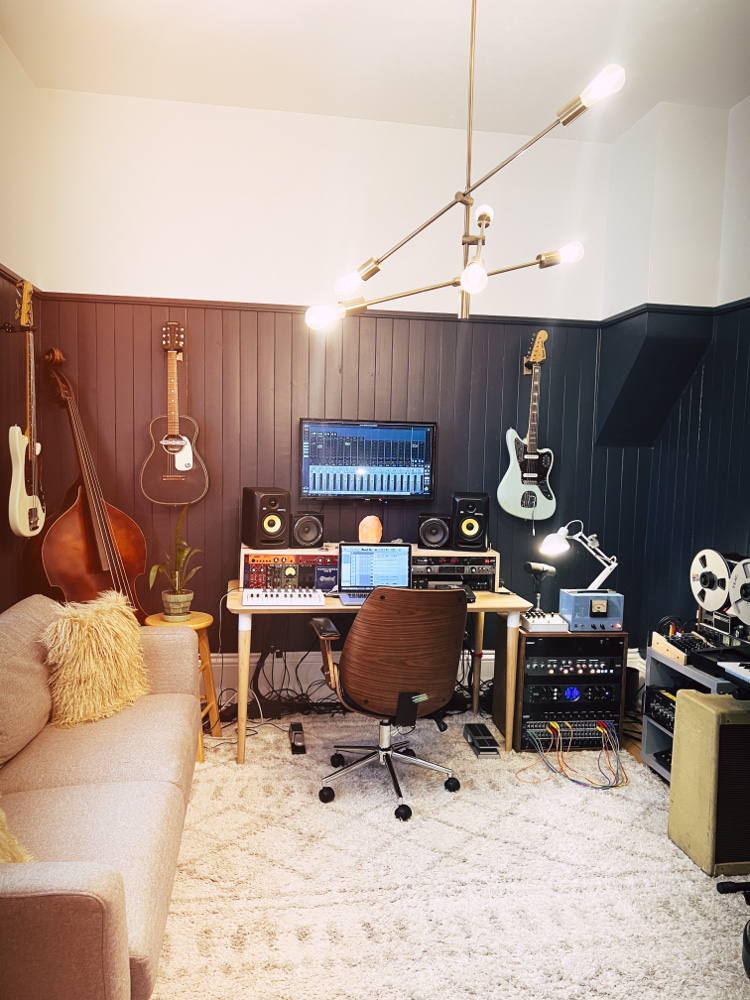When the Producer, Mixer and Artist Converge: Hill Kourkoutis Builds Hits
Some breakthroughs are strictly personal. Others reverberate on a grand scale.
For producer/mixer/songwriter Hill Kourkoutis, recent revelations have been far-reaching: This past May she became the first woman in the history of Canada’s JUNO Awards to win Recording Engineer of the Year.
The recognition arrives during a hot streak for Kourkoutis, who operates out of her private studio The Lair just north of Toronto. She produced/mixed/engineered the rock artist SATE’s 2021 JUNO-nominated album The Fool, and folk/roots singer Tania Joy’s 2021 record I Will Stand. Kourkoutis also co-wrote and produced pop muse Cassie Dasilva’s 1.1 million+ streams hit “Unsolicited Contact”, which stands as an utterly addictive track.
A multi-instrumentalist and composer as well, Kourkoutis’ success springs from nurturing a diversified mindset. A certified road warrior singer/songwriter before she gravitated full-time to the studio, she leverages her empathy with music artists to forge a deep rapport in the studio. That approach not only unlocks new levels of creativity in her clients, it also allows her to move at high speed during the mix phase.
Want to expand your professional sphere of influence? Look to Hill Kourkoutis as a guide. From advanced remote recording workflows to building hits in the studio, to her visual approach of establishing space in a mix, this SonicScoop Q&A provides career-building insights.
Building Trust: The Key to Recording Creativity
Hill, congratulations on your Juno win for Recording Engineer of the Year! How would you characterize what winning that award means to you?
It was pretty surreal. It was an immense honor — something that you dream of getting as a kid if you aspire to be a musician. It’s opened up a lot of great conversations around women in the technical fields of music, which has been really great.
What was the progress that an award like this can spur for women in the audio field? What’s the progress that remains to be made?
One of the greatest things that happens with something like this is that you see yourself represented in the field. I think that’s really important because visibility and representation are the things that will help equalize the gender gap in the technical field.
The reason why I got into it is because there was an example before me. Trina Shoemaker and Sheryl Crow were two of my biggest inspirations, and showed me that was a path that was an option. To see yourself represented in a place where you haven’t had representation before, at least in Canada at the Junos, there’s never been a woman nominated in that category before, so that felt like a big move.
But I also think it’s the awesome conversations that have been started through this nomination and win because I’ve been able to start credibly talking about women that are already making awesome records. It’s a lot bigger of a number than people think, and there are definitely more women entering the profession too. It’s really exciting to be able to also talk about the awesome work they’re doing.
What was it about the SATE and Tania Joy albums that you believe stood out, and helped you break through at the Juno awards?
It’s hard to tell because I wasn’t even sure if I would win — I was against some pretty heavy hitters with these amazing peers of mine. I’m actually just really honored that people resonated with those records. They were very interesting records to make because they were made during the pandemic, and so they were made in a very untraditional way. In Tania Joy’s case, I actually didn’t meet her in person until the day before the Juno’s, because we worked on her entire record remotely.
I think that there’s such an honesty in both SATE and Tania’s storytelling and maybe that’s what resonated with people. I was just able to facilitate that because they trusted me implicitly with their creative process.
Lessons from the Pandemic: Better Remote Recording
What habits or best practices did you learn about producing and recording during the pandemic that you’re carrying over now?
It was finding a way to transfer what I would do if I was in the studio with somebody and find a way to do that in a really genuine way remotely. The most important foundation for me in terms of having a great relationship with an artist is establishing a solid foundation of trust and respect. I believe that if that’s there, the artist is willing to go to those really vulnerable places and get a really honest performance, and also complement the storytelling amidst all that.
But I think it organically grows through that relationship that’s developed, so I like to do what I refer to as a bit of a “dating period”, where we really get to know each other and build a bond and a friendship, because then we’re able to really trust each other in that process.
Trust sounds like a very important component.
That was a really big part of it, and then after that when it comes to the technical, we’re really lucky nowadays to live in an age where we’re able to execute a lot of things remotely. I had already been doing that in some capacity — like I was doing Skype writing sessions before there was Zoom with people. Again, it’s not the same as being in person, but it works if you can’t be together.
I do work with a lot of artists that don’t live in the same city as I do, so I’ve done certain stretches of albums remotely and found a way of creating a workflow where I’ll start some ideas. Then we tag team tracks back and forth until we get things to a place where we’re all happy.
So we carried that [remote workflow experience] into it, and then the extra element was trying to find a way to coach people through getting these home remote recording setups so that they could record their own vocals and get that stuff sent back to me. It was a bit of a thing that all of us had to adapt to, but we managed to do it.
Are there any specific remote recording tools that you use that you can tell our readers about that were particularly helpful to you?
I’ve been using a program called Loopback. That’s the latest one I’ve settled on after trying a bunch of different ones. Loop Back is really cool because I’m able to control multiple audio sources from my computer, not just Pro Tools, and link everything through Zoom. So I use Zoom and Loopback in tandem for all that kind of stuff. And I’m able to do mix sessions where people could hear things in a really high definition quality and make their notes.
From Songwriter to Studio Pro
Let’s back up a little. How does your background as a songwriter inform you as an engineer and a mixer?
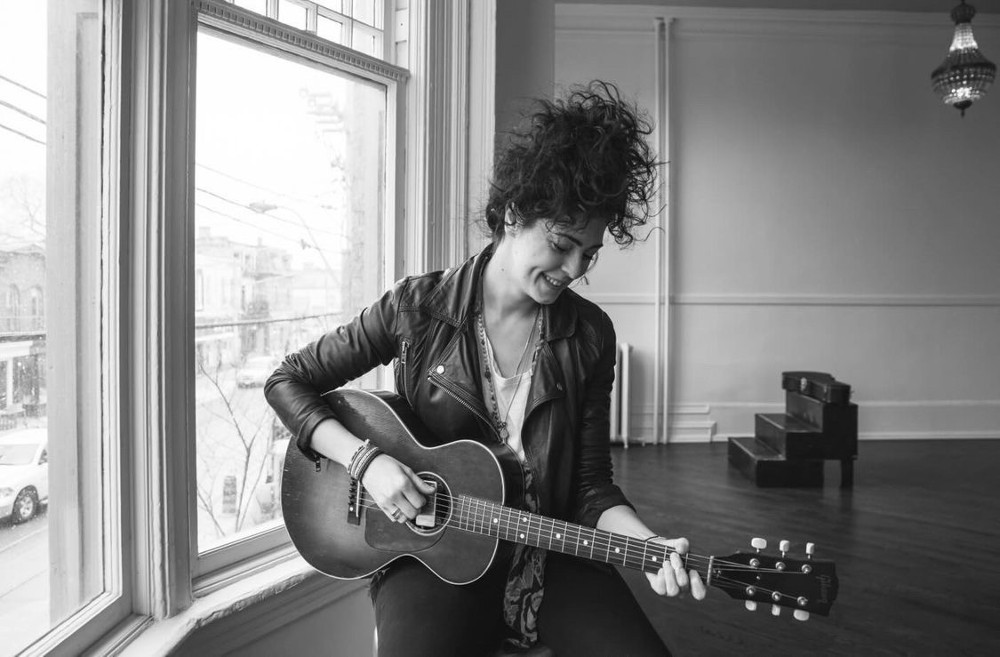
As a multi-instrumentalist, Kourkoutis can create a complete beat quickly. (Photo credit Lisa MacIntosh)
It’s a mix of things that inform me because I’ve been a bit of a jack-of-all-trades in the industry. I started off as an artist doing my own thing, and within that’s when I started to explore being a multi-instrumentalist and a songwriter.
I’ve also put out my own records, I had my own independent label, and I also went to film school and I directed music videos commercially for a while too. I think all of those aspects of what I’ve done informed the production process, because I’m aware of all the moving parts of what it takes to not only get your music out there, but what it feels like to be an artist.
That’s the most important place that I come from, is I always think to myself of how I felt when I was an artist in the studio, and how I always knew what I wanted but I couldn’t necessarily articulate things at the time. I’m very mindful of that, that artists ultimately know who they are and what they want but they don’t always know how to get there, so that’s my primary role.
I love that you were a music video director because I love a great music video! At its best, what do you think a good music video can add to a song?
That’s what the appeal was for me in making them. To me, when you can create the ultimate musical cinematic experience, you can enhance the experience of the meaning of a song when it comes to the visual aid of it.
That’s also a big part of how I approach my production: There’s always a cinematic influence or reference happening in my mind when we’re creating that body of work, because when you can unite those things, you can make it that much more impactful. You make it that much more connected in a way.
There’s a certain visceral, kinesthetic response that you can get from seeing something. When it has that right song connected to it as well, it’s just otherworldly. It hits the point and makes it that much more impactful.
Hill Koukourtis directed the video for San Sebastian’s “Wake Up”:
Music Production Culture: How Canada Stands Out
Let’s talk about your studio in Toronto, The Lair, is it a commercial or a private studio? How is it set up to support your workflow and creative sensibilities?
It’s a private studio. During the pandemic I left Toronto and moved just north of the city, and now the studio lives in a room in my house. Because I travel a lot, I’ve made it so that I can have a mobile version of my studio and then tether into a kind of mother setup over here.
I work in a digital analog hybrid way, so everything’s set up in terms of workflow so that I can, whether I’m writing, producing, mixing or recording, have everything ready to go at all times, or it’s very easy to patch things in very quickly.
Most of my setup is based around an Apollo setup, that’s my main interface. I like using plugins, but I also love tube things. So I have a bunch of analog gear as well, just to get those colors that you can’t get from a solely digital in-the-box setup.
And then I have a bunch of instruments. I play a bit of everything, so there’s a bit of everything laying around the entire house. If I want to go track drums in my living room or dining room or hallway, I can easily set that up and make that happen.
What are some of the analog boxes that are your go-to units?
Well, on the preamp front, I have an Acme MTP 66, which is their Motown tube preamp that I just adore. It’s actually amazing because I was trying to get that Motown sound when I was primarily in the box for so many years and it’s just amazing with this box — I just plug in and I have that sound instantly.
Also on the Acme front, I have their 500 series Opticom compressor, which is the secret sauce I use on everything. If I’m struggling with something in the mix, I know I can just run it through that and it’s just going to fix everything. It sounds so warm and gorgeous. On the mix bus front, I have an SSL Fusion that I’ve chained into a Manley Nu Mu [stereo limiter/compressor], so I usually have that going on the mix bus.
I primarily use Pro Tools [for mixing and] even for tracking. I use Logic and have mixed in Logic before, but I started off on Pro Tools and I think that is a comfort thing more than anything.
What does the Motown sound represent to you and why is it desirable?
It’s just indicative of some of the most beautiful songs and recordings that I grew up listening to, and there was something magical about listening to Motown records. And I don’t know what it was — I think it was just a mixture of the creative kind of bubble that they had created that was just so magical.
But there was something about that sound too, and I guess now if I could articulate it, it’s because of all of that custom gear that they had made. It’s one thing to have the gear and it’s also about having that perfect storm of people coming together in order to execute that. But I think it’s the feeling that it gives you, it’s just real and it’s raw.
Hill named Stevie Wonder’s “I Don’t Know Why” as a Motown personal favorite:
How would you characterize the studio scene in Toronto?
It’s an incredible scene. We have a lot of great studios in Toronto, and what’s really cool about them is each one has its own charm and unique appeal of why you would want to go track there. I do frequently work out of many of the studios in the city because of that. I like that I can choose a room based on what the songs and the record needs.
Yeah. Can you name a few studios?
Absolutely, I’d love to. One of my favorites is The Canterbury Music Co., which is really great for so many reasons. They have an insane live room. If you like to do live off-the-floor tracking, that’s the primary reason that I like to go there, but they also have a beautiful Neve 8026 console, which is one of very few made and it just has such a great tone to it. And I love myself a good Neve console, so that’s the spot I go to. They have an amazing mic locker too.
I also like to track drums at my friend’s John Dinsmore’s spot, which is called Lincoln County Social Club. He has a lot of vintage gear. If you want to get those old school Motown-y kind of Black Keys vibes, then I love going there for that. There’s also Revolution Recording and Noble Street Studios, which are the other probably top two big commercial spots in the city as well.
What would you say distinguishes the Canadian music production industry scene?
One thing about the Canadian scene in general is we’ve had quite an eclectic group of artists break internationally. I think that’s reflective of the scenes that are happening across the country, especially in Toronto there’s a lot of people that have come out of this city that just span so many genres.
Being immersed in this scene is very inspiring because you could be in a completely different genre, for example, as an artist, but everybody is friends with each other and I think that informs the music. We all inspire each other, and a lot of the producers working here aren’t just working in one genre or one scene — we’re all working together collectively.
“Unsolicited Contact”: How to Produce an Addictive Hit
You co-wrote and produced Cassie Dasilva’s “Unsolicited Contact”, what’s the key to creating an addictive single like that? I cannot listen to that song just once.
Yeah, that song’s an ear worm for sure for me as well. Mad credit to Cassie because she is such an incredible songwriter and storyteller, and anytime I’ve gone in to do a session with her, she always comes into the room with an idea based on some crazy experience that she’s had in that short-term period.
It was one of those songs that came together pretty quickly. She came in because it was literally verbatim what the lyrics start getting into in the song, she’s like, “My ex texted me on my birthday, but he didn’t wish me a happy birthday. It’s like he didn’t even know it was my birthday and he just starts talking about our relationship and how it informed his new relationship. He was like thanking me, and it was just weird. Should I be weirded out by this?”
And so we talked about that for a bit, and then she was like, “I think I want to write about this today.” So I was like, “Okay yeah, for sure.” The lyric poured out instantly, and while she was reading me her prompt of what she was working on, I just started building the beat and it unraveled from there.
It happened very organically and I think that’s the key sometimes. The songs pretty much write themselves, and I think that if you’re present within them and you don’t overthink it, it just kind of flows out and you find your way through them. They inform themselves.
How did you build the beat?
I started off just playing that guitar riff that opens up with, just to get a bit of a chord progression happening. And then while we were playing that, because there’s such a tongue-in-cheek sassy nature to that song, we wanted the beat to reflect that.
The first thing that came to mind was that straight beat that started playing on top, so I just did a straight beat with a kick and a snare. I laid down that guitar part, and then I was hearing this pulse so then that’s when I added that keyboard part that comes in. It’s like a bit of a marimba muted percussive keyboard sound. It unfolded from there, but that’s how it started out.
Quick Mixing: The Producer’s Advantage
Tell me about your approach as a mixer. How do you build up a mix?
It varies if I’m getting a track to mix versus transitioning from something I’m producing into a mix, but I do the latter mostly. To transition into a mix, I mix along the way when I produce because I’m already hearing a lot of the nuances.
Especially nowadays, I think people want to start hearing the song as it’s going to sound pretty quickly throughout the process. The notion of listening to raw files is reserved for certain types of musicians, but most artists want to feel everything feeling very polished relatively quickly in the process. So I start doing preliminary EQ-ing and compressing and stuff while I’m producing.
But then when I switch to mix mode, I like to organize everything by instrument groups first and create all my auxiliary channels. Then I’ll pretty much go through and, track by track, start treating everything.
I usually start with the drums and, very similar to doing a live sound check, I’ll start with the kicks and the snares and the high hats and go through the entire kit. Then I’ll move into the percussion layers, and then I’ll move into any effects that are happening. From there, I use the drums as kind of the space that I relate to I think.
Can you expand on what you mean by that?
Absolutely. When I’m thinking about mixing, I’m almost thinking about the song as a room, right? And so in being able to understand what type of room I’m standing in, and where the drums are sitting within that room, then I kind of get an idea of where the walls are, and where the ceiling and the floor is, and spatially the dimensions that I have too. It’s a visual way of thinking about it, but this is going back to the visual side of my brain.
Having an anchor point, and then relating all of the instrumentation and the vocals and also all the effects that we’re using [works] because when we’re talking about mixing, delays and reverbs start to be used as modes of placing things within space as well. So I think having one place to anchor, to relate to, is pretty important for how I understand and perceive a mix.
I’m relating everything back to the drums, and for me the drums are the heartbeat of everything, right? So if the drums can still have an impact and come through by the end of a mix, but everything has found their space around that, that tells me that we’ve been successful within the mixing process.
You work with some outstanding vocalists. In general, what can you say about mixing vocals and how you’ve progressed with it?
One of the biggest things ideally that you could do for vocals is obviously finding the right mic for the right singer, because I think that the way that it’s recorded going in is very telling on what you can do with the mix after the fact.
But if I don’t have control over that, then the thing that I’m listening for is the raw vocal files because I get a sense of what the vocalist’s timbre is and then, based on that, I can reference what sorts of preamps or EQs or compressors that I feel would be complementary to run their vocals through. In that regard, I don’t have a set chain that I like to use because it is unique to whatever the vocalist requires.
But generally, you want the vocals to be the focal point because that’s the narrative, that’s how the story is being told. And it just depends on the singer, like in SATE’s case, she really loves having a lot of saturation on her voice. That’s something that we play around with and she sounds really amazing through tube gear, so that’s usually the approach I’ll take with a vocalist like that.
When it comes to all that tube saturation stuff, I do like to run vocals through the analog equipment. But on a lot of pop tracks, I’ll mix those things completely in the box using a lot of the UAD plugins, those are my main go-tos for a lot of stuff. In Cassie’s case I think I ran her through the Manley VoxBox [tube channel strip] just because again, it gave me that really warm tube quality, but it still had a bit of a sparkle and a polish on it.
But it’s hard to say how I treat the vocal, because it really depends on the song and the artist and what the song sounds like. That will even influence which delays and reverbs we’re using. But generally, my rule is that if I’m working in the box, I’ll use one of the UAD virtual preamps. I’ll have an EQ — I really love the Pultec EQs, I use those a lot on vocals. I’ll run it through a compressor, either the LA-2A or if I’m running it through my gear I’ll either use the Manley Nu Mu or the Acme Opticom.
And then find whatever set of delays. Sometimes I’ll add some harmonic saturation or distortion, and then I’ll add the delays and the reverbs after that.
Career Guidance: “Take Your Time”
Hill, this has been such an insightful interview. Last question: What’s your advice for emerging music pros who want to build a diversified practice as a songwriter, producer, and mixer, as you have?
I say take your time because these things do take time. It’s important to find what your style and approach is. And really be open to experiences, because I think once you can understand the nuances of doing those things in practice, then that’s what’s going to inform how you progress.
But it’s also a constant learning experience, and I think that’s the beauty of what we do: You’re always learning and you should be open to learning, and not get overwhelmed or daunted by the fact that you don’t know everything right now. That doesn’t matter. Because the purpose is to live your way into learning and knowing.
— David Weiss is an Editor for SonicScoop.com, and has been covering pro audio developments for over 20 years. He is also the co-author of the music industry’s leading textbook on synch licensing, “Music Supervision, 2nd Edition: The Complete Guide to Selecting Music for Movies, TV, Games & New Media.” Email: david@sonicscoop.com
Please note: When you buy products through links on this page, we may earn an affiliate commission.








